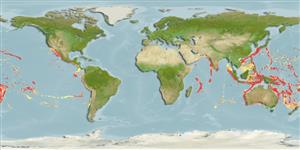Common names from other countries
Classification / Names / Names
ชื่อสามัญ | ชื่อพ้อง | Catalog of Fishes (gen., sp.) | ITIS | CoL | WoRMS
Environment: milieu / climate zone / depth range / distribution range
นิเวศวิทยา
กลุ่มสัตว์หน้าดิน,กลุ่มสัตว์พื้นท้องน้ำ; ระดับความลึก 200 - 1475 m (Ref. 96667). Deep-water; 33°N - 40°S, 54°E - 71°W
Indo-Pacific.
Length at first maturity / ขนาด / น้ำหนัก / Age
Maturity: Lm ? range ? - ? cm
Typically found near the sea floor in deep-seas. Its characteristic 3 pairs of extremely long, stilt-like pereiopods suggest its ability to walk on soft sediments. An opportunistic feeder, relying on phototrophically derived organic matter. Its feeding strategy may be assumed to be similar with its congener, N. exilis, a scavenger and predator that feeds mainly on fish remains and slow-moving benthic organisms. Shown to produce oval eggs (0.5 to 0.65 mm length) and may possibly achieve several reproductive outputs in its relatively long lifespan of 2 to 3 years (Ref. 97382).
Life cycle and mating behavior
วัยเจริญพันธุ์ | การสืบพันธุ์ | การวางไข่ | เซลสืบพันธ์ของเพศเมีย(ไข่) | ความดกของไข่ | ตัวอ่อน
Members of the order Decapoda are mostly gonochoric. Mating behavior: Precopulatory courtship ritual is common (through olfactory and tactile cues); usually indirect sperm transfer.
Poupin, J. 1998. (Ref. 75706)
IUCN Red List Status (Ref. 130435)
CITES status (Ref. 108899)
Not Evaluated
Not Evaluated
Human uses
| FishSource |
เครื่องมือ
ข้อมูลเพิ่มเติม
Age/Size
การเจริญเติบโต
Length-weight
Length-length
สัณฐานวิทยา
ตัวอ่อน
อุดมสมบรูณ์
แหล่งที่มาจากอินเตอร์เน็ต
Estimates based on models
Preferred temperature
(Ref.
115969): 6 - 12.8, mean 8.3 (based on 423 cells).
Price category
Unknown.
